Critical Rolling Process Parameters for Dynamic Recrystallization Behavior of AZ31 Magnesium Alloy Sheets
Abstract
:1. Introduction
2. Experimental Procedures
3. Results and Discussion
3.1. Microstructure Characteristics
3.2. Texture Characteristics
3.3. Tensile Test Results
4. Conclusions
Author Contributions
Funding
Conflicts of Interest
References
- Leng, Z.; Zhang, J.; Zhu, T.; Wu, R.; Zhang, M.; Liu, S.; Sun, J.; Zhang, L. Microstructure and mechanical properties of Mg-(6,9)RY-4Zn alloys by extrusion and aging. Mater. Des. (1980-2015) 2013, 52, 713–719. [Google Scholar] [CrossRef]
- Chino, Y.; Sassa, K.; Kamiya, A.; Mabuchi, M. Stretch formability at elevated temperature of a cross-rolled AZ31 Mg alloy sheet with different rolling routes. Mater. Sci. Eng. A 2008, 473, 195–200. [Google Scholar] [CrossRef]
- Agnew, S.R.; Duygulu, Ö. Plastic anisotropy and the role of non-basal slip in magnesium alloy AZ31B. Int. J. Plast. 2005, 21, 1161–1193. [Google Scholar] [CrossRef]
- Somekawa, H.; Kinoshita, A.; Washio, K.; Kato, A. Enhancement of room temperature stretch formability via grain boundary sliding in magnesium alloy. Mater. Sci. Eng. A 2016, 676, 427–433. [Google Scholar] [CrossRef]
- Chen, W.Z.; Yu, Y.; Wang, X.; Wang, E.D.; Liu, Z.Y. Optimization of rolling temperature for ZK61 alloy sheets via microstructure uniformity analysis. Mater. Sci. Eng. A 2013, 575, 136–143. [Google Scholar] [CrossRef]
- Robson, J.D.; Henry, D.T.; Davis, B. Particle effects on recrystallization in magnesium–manganese alloys: Particle-stimulated nucleation. Acta Mater. 2009, 27, 2739–2747. [Google Scholar] [CrossRef]
- Han, T.; Huang, G.; Deng, Q.; Wang, G.; Jiang, B.; Tang, A.; Zhu, Y.; Pan, F. Grain refining and mechanical properties of AZ31 alloy processed by accumulated extrusion bonding. J. Alloys Compd. 2018, 745, 599–608. [Google Scholar] [CrossRef]
- Imandoust, A.; Barrett, C.D.; Oppedal, A.L.; Whittington, W.R.; Paudel, Y.; El Kadiri, H. Nucleation and preferential growth mechanism of recrystallization texture in high purity binary magnesium-rare earth alloys. Acta Mater. 2017, 138, 27–41. [Google Scholar] [CrossRef]
- Barrett, C.D.; Imandoust, A.; Oppedal, A.L.; Inal, K.; Tschopp, M.A.; El Kadiri, H. Effect of grain boundaries on texture formation during dynamic recrystallization of magnesium alloys. Acta Mater. 2017, 128, 270–283. [Google Scholar] [CrossRef]
- Zhang, L.; Chen, W.; Zhang, W.; Wang, W.; Wang, E. Microstructure and mechanical properties of thin ZK61 magnesium alloy sheets by extrusion and multi-pass rolling with lowered temperature. J. Mater. Process. Technol. 2016, 237, 65–74. [Google Scholar] [CrossRef]
- Wang, W.; Zhang, W.; Chen, W.; Yang, J.; Zhang, L.; Wang, E. Homogeneity improvement of friction stir welded ZK61 alloy sheets in microstructure and mechanical properties by multi-pass lowered-temperature rolling. Mater. Sci. Eng. A 2017, 703, 17–26. [Google Scholar] [CrossRef]
- Cho, J.H.; Jeong, S.S.; Kang, S.B. Deep drawing of ZK60 magnesium sheets fabricated using ingot and twin-roll casting methods. Mater. Des. 2016, 110, 214–224. [Google Scholar] [CrossRef]
- Suh, J.; Victoria-Hernández, J.; Letzig, D.; Golle, R.; Volk, W. Enhanced mechanical behavior and reduced mechanical anisotropy of AZ31 Mg alloy sheet processed by ECAP. Mater. Sci. Eng. A 2016, 650, 523–529. [Google Scholar] [CrossRef] [Green Version]
- Kim, W.J.; Yoo, S.J.; Chen, Z.H.; Jeong, H.T. Grain size and texture control of Mg-3Al-1Zn alloy sheet using a combination of equal-channel angular rolling and high-speed-ratio differential speed-rolling processes. Scr. Mater. 2009, 60, 897–900. [Google Scholar] [CrossRef]
- Kim, W.J.; Lee, J.B.; Kim, W.Y.; Jeong, H.T.; Jeong, H.G. Microstructure and mechanical properties of Mg-Al-Zn alloy sheets severely deformed by asymmetrical rolling. Scr. Mater. 2007, 56, 309–312. [Google Scholar] [CrossRef]
- Wang, W.; Chen, W.; Zhang, W.; Cui, G.; Wang, E. Effect of deformation temperature on texture and mechanical properties of ZK60 magnesium alloy sheet rolled by multi-pass lowered-temperature rolling. Mater. Sci. Eng. A 2018, 712, 608–615. [Google Scholar] [CrossRef]
- Chen, W.Z.; Zhang, W.C.; Zhang, L.X.; Wang, E.D. Property improvements in fine-grained Mg-Zn-Zr alloy sheets produced by temperature-step-down multi-pass rolling. J. Alloys Compd. 2015, 646, 195–203. [Google Scholar] [CrossRef]
- Liu, D.; Bian, M.Z.; Zhu, S.M.; Chen, W.Z.; Liu, Z.Y.; Wang, E.D.; Nie, J.F. Microstructure and tensile properties of Mg-3Al-1Zn sheets produced by hot-roller-cold-material rolling. Mater. Sci. Eng. A 2017, 706, 304–310. [Google Scholar] [CrossRef]
- Ma, Q.; Li, B.; Whittington, W.R.; Oppedal, A.L.; Wang, P.T.; Horstemeyer, M.F. Horstemeyer, Texture evolution during dynamic recrystallization in a magnesium alloy at 450 °C. Acta Mater. 2014, 67, 102–115. [Google Scholar] [CrossRef]
- Iwanaga, K.; Tashiro, H.; Okamoto, H.; Shimizu, K. Improvement of formability from room temperature to warm temperature in AZ-31 magnesium alloy. J. Mater. Process. Technol. 2004, 155, 1313–1316. [Google Scholar] [CrossRef]
- Song, B.; Xin, R.; Liao, A.; Yu, W.; Liu, Q. Enhancing stretch formability of rolled Mg sheets by pre-inducing contraction twins and recrystallization annealing. Mater. Sci. Eng. A 2015, 627, 369–373. [Google Scholar] [CrossRef]
- Huang, X.; Suzuki, K.; Chino, Y.; Mabuchi, M. Improvement of stretch formability of Mg-3Al-1Zn alloy sheet by high temperature rolling at finishing pass. J. Alloys Compd. 2011, 509, 7579–7584. [Google Scholar] [CrossRef]
- Zhou, T.; Yang, Z.; Hu, D.; Feng, T.; Yang, M.; Zhai, X. Effect of the final rolling speeds on the stretch formability of AZ31 alloy sheet rolled at a high temperature. J. Alloys Compd. 2015, 650, 436–443. [Google Scholar] [CrossRef]
- Kaibyshev, R.; Shipilova, K.; Musin, F.; Motohashi, Y. Continuous dynamic recrystallization in an Al-Li-Mg-Sc alloy during equal-channel angular extrusion. Mater. Sci. Eng. A 2005, 396, 341–351. [Google Scholar] [CrossRef]
- Chen, W.; Wang, X.; Hu, L.; Wang, E. Fabrication of ZK60 magnesium alloy thin sheets with improved ductility by cold rolling and annealing treatment. Mater. Des. 2012, 40, 319–323. [Google Scholar] [CrossRef]
- Wang, W.; Ma, L.; Chai, S.; Zhang, W.; Chen, W.; Feng, Y.; Cui, G. Role of one direction strong texture in stretch formability for ZK60 magnesium alloy sheet. Mater. Sci. Eng. A 2018, 730, 162–167. [Google Scholar] [CrossRef]
- Li, G.; Zhang, J.; Wu, R.; Feng, Y.; Liu, S.; Wang, X.; Meng, J. Development of high mechanical properties and moderate thermal conductivity cast Mg alloy with multiple RE via heat treatment. J. Mater. Sci. Technol. 2018, 34, 1076–1084. [Google Scholar] [CrossRef]
- Chen, W.Z.; Wang, X.; Kyalo, M.N.; Wang, E.D.; Liu, Z.Y. Yield strength behavior for rolled magnesium alloy sheets with texture variation. Mater. Sci. Eng. A 2013, 580, 77–82. [Google Scholar] [CrossRef]
- Hong, S.G.; Park, S.H.; Lee, C.S. Role of {10-12} twinning characteristics in the deformation behavior of a polycrystalline magnesium alloy. Acta Mater. 2010, 58, 5873–5885. [Google Scholar] [CrossRef]
- Xu, Y.; Hu, L.; Sun, Y. Deformation behaviour and dynamic recrystallization of AZ61 magnesium alloy. J. Alloys Compd. 2013, 580, 262–269. [Google Scholar] [CrossRef]
- Trang, T.T.T.; Zhang, J.H.; Kim, J.H.; Zargaran, A.; Hwang, J.H.; Suh, B.C.; Kim, N.J. Designing a magnesium alloy with high strength and high formability. Nat. Commun. 2018, 9, 2522. [Google Scholar] [CrossRef] [PubMed]
- Zhang, W.; Wang, W.; Chen, W.; Wang, E. Optimization of Rolling Condition for ZK61 Alloy Sheets via Microstructure and Mechanical Property Analysis. J. Mater. Eng. Perform. 2016, 25, 5551–5559. [Google Scholar] [CrossRef]
- Wang, Y.N.; Huang, J.C. Texture analysis in hexagonal materials. Mater. Chem. Phys. 2003, 81, 11–26. [Google Scholar] [CrossRef]
- Wang, W.; Cui, G.; Zhang, W.; Chen, W.; Wang, E. Evolution of microstructure, texture and mechanical properties of ZK60 magnesium alloy in a single rolling pass. Mater. Sci. Eng. A 2018, 724, 486–492. [Google Scholar] [CrossRef]
- Xin, R.; Wang, M.; Huang, X.; Guo, C.; Liu, Q. Observation and Schmid factor analysis of multiple twins in a warm-rolled Mg-3Al-1Zn alloy. Mater. Sci. Eng. A 2014, 596, 41–44. [Google Scholar] [CrossRef]
- Wang, W.; Zhang, W.; Chen, W.; Cui, G.; Wang, E. Effect of initial texture on the bending behavior, microstructure and texture evolution of ZK60 magnesium alloy during the bending process. J. Alloys Compd. 2018, 737, 505–514. [Google Scholar] [CrossRef]
- Wang, Y.; Choo, H. Influence of texture on Hall–Petch relationships in an Mg alloy. Acta Mater. 2014, 81, 83–97. [Google Scholar] [CrossRef]
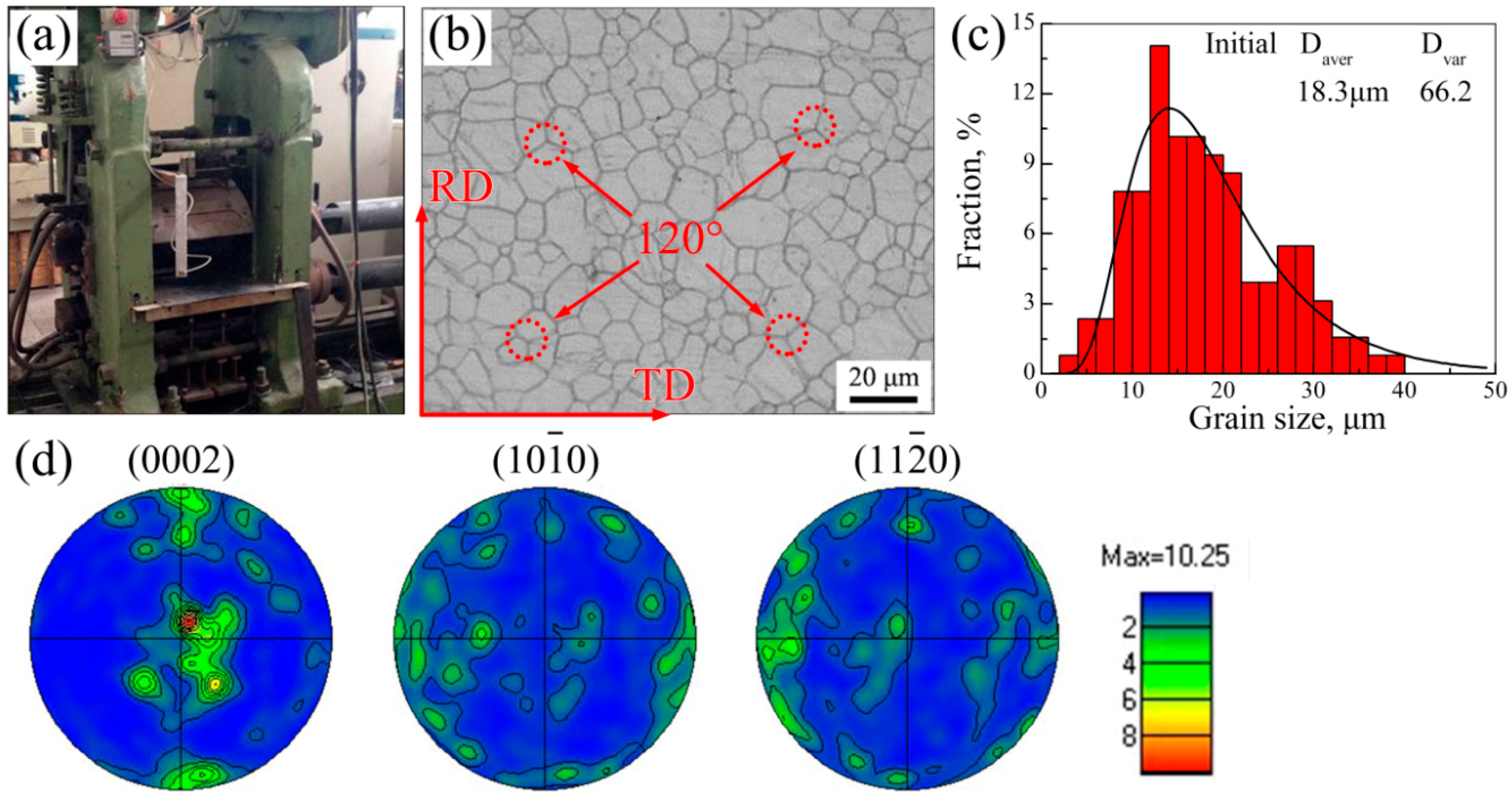
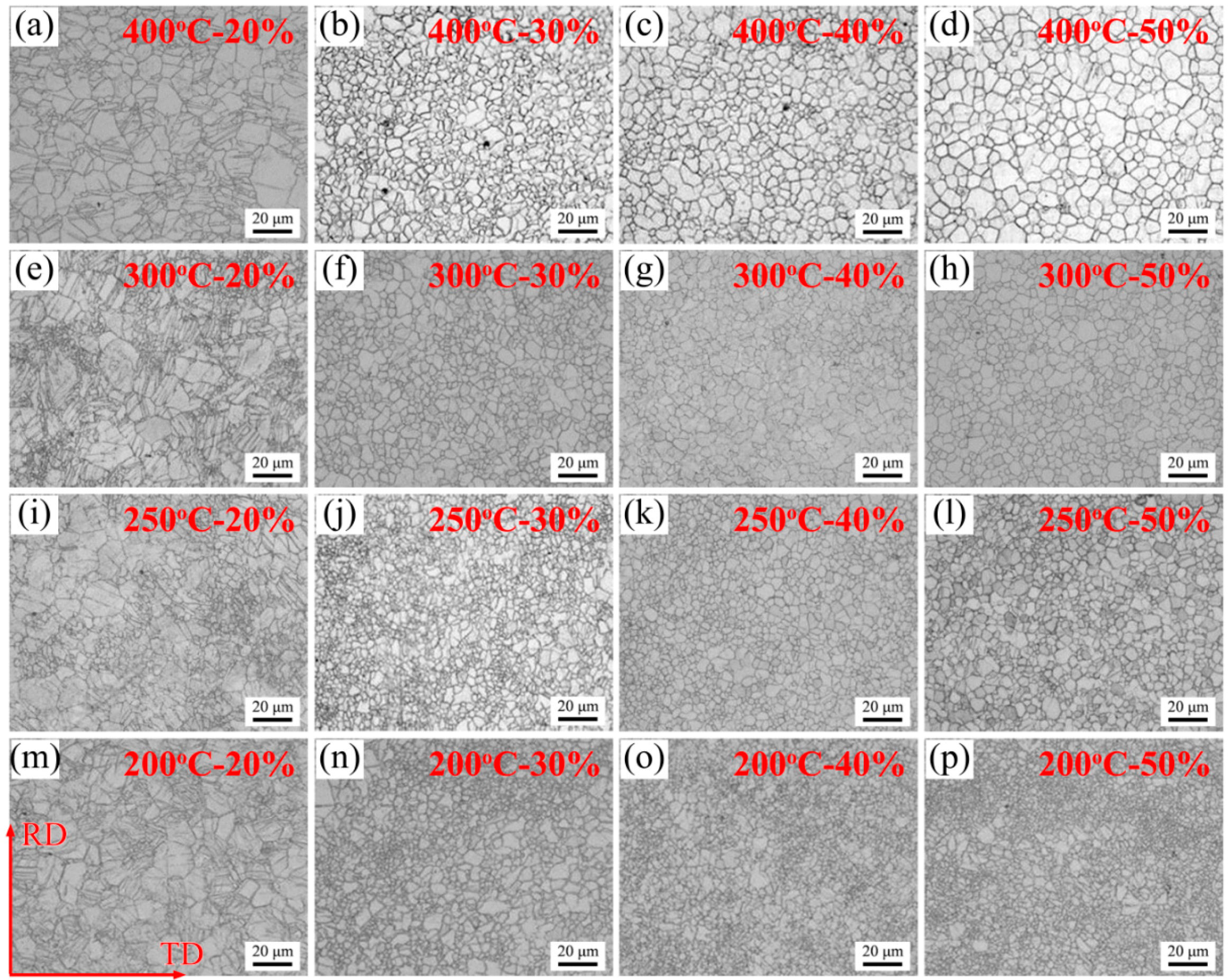
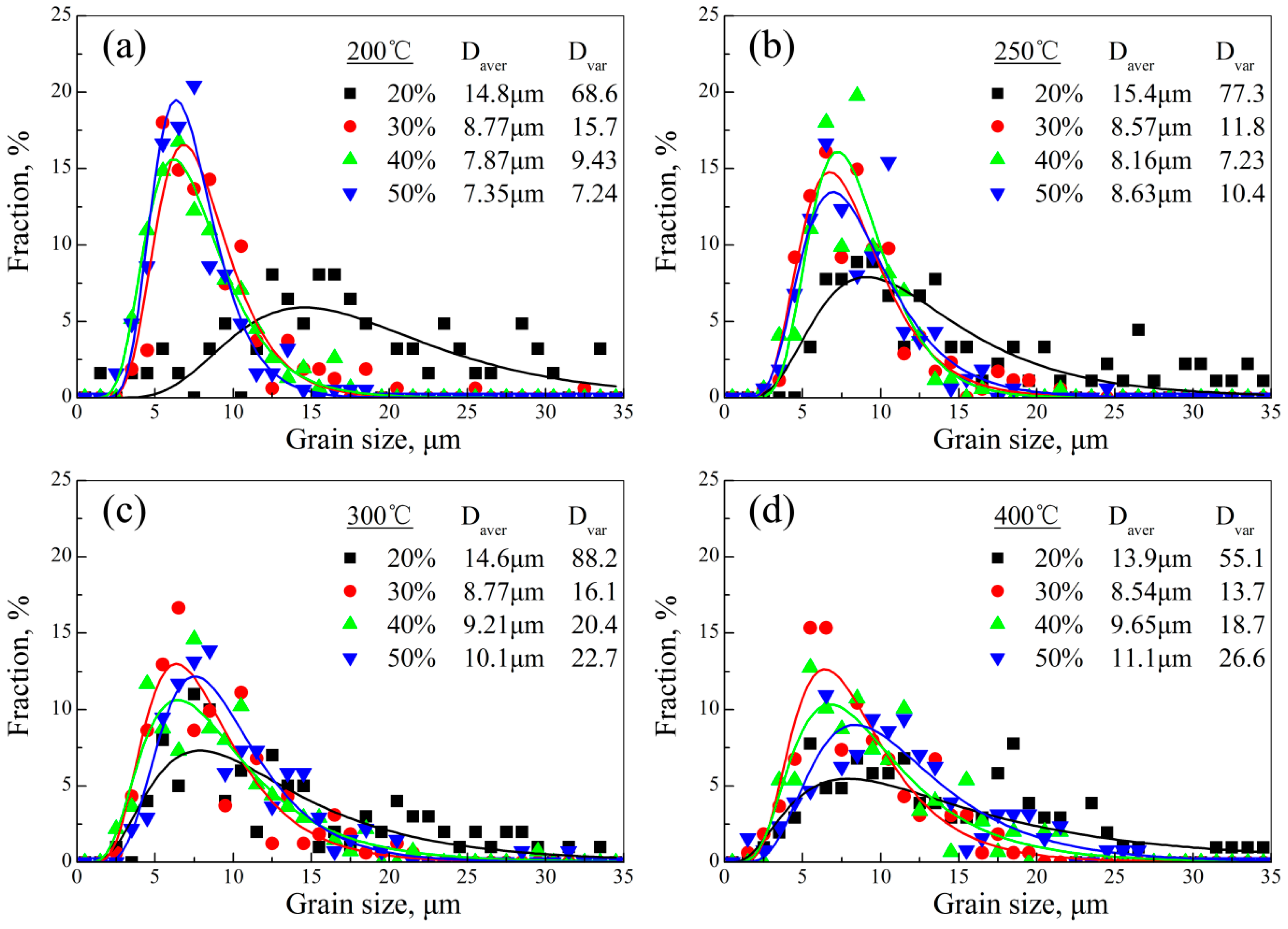
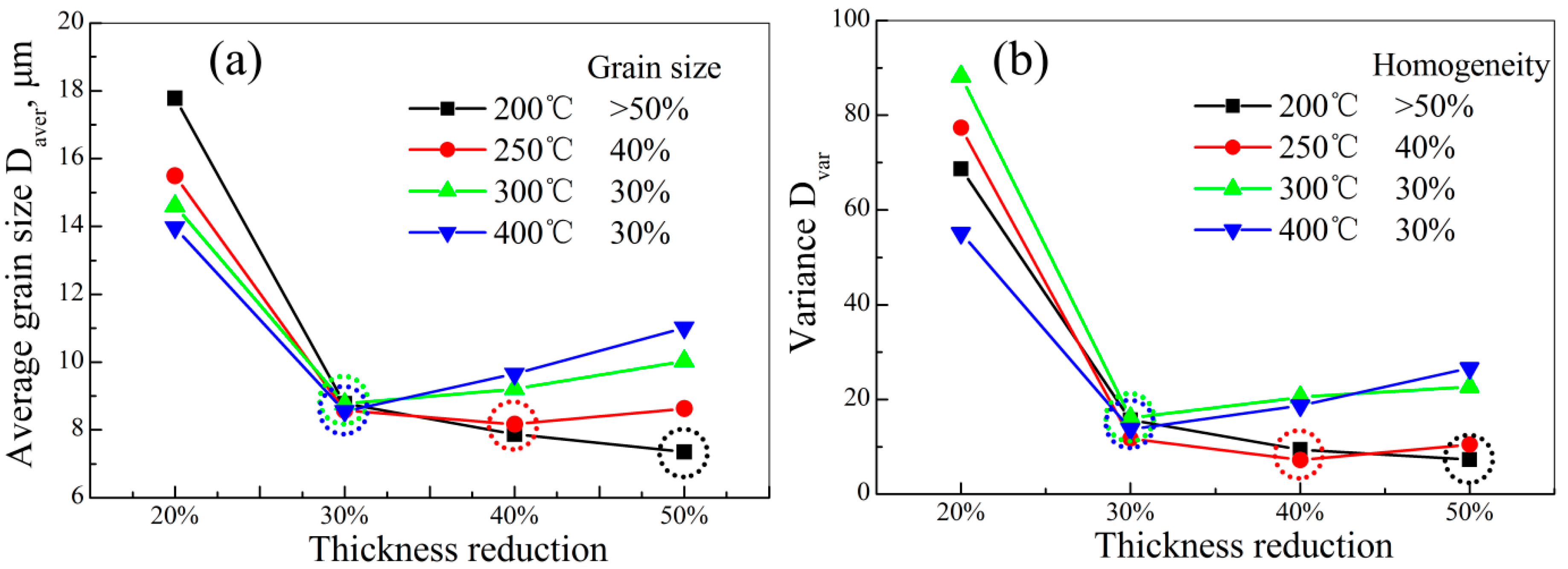

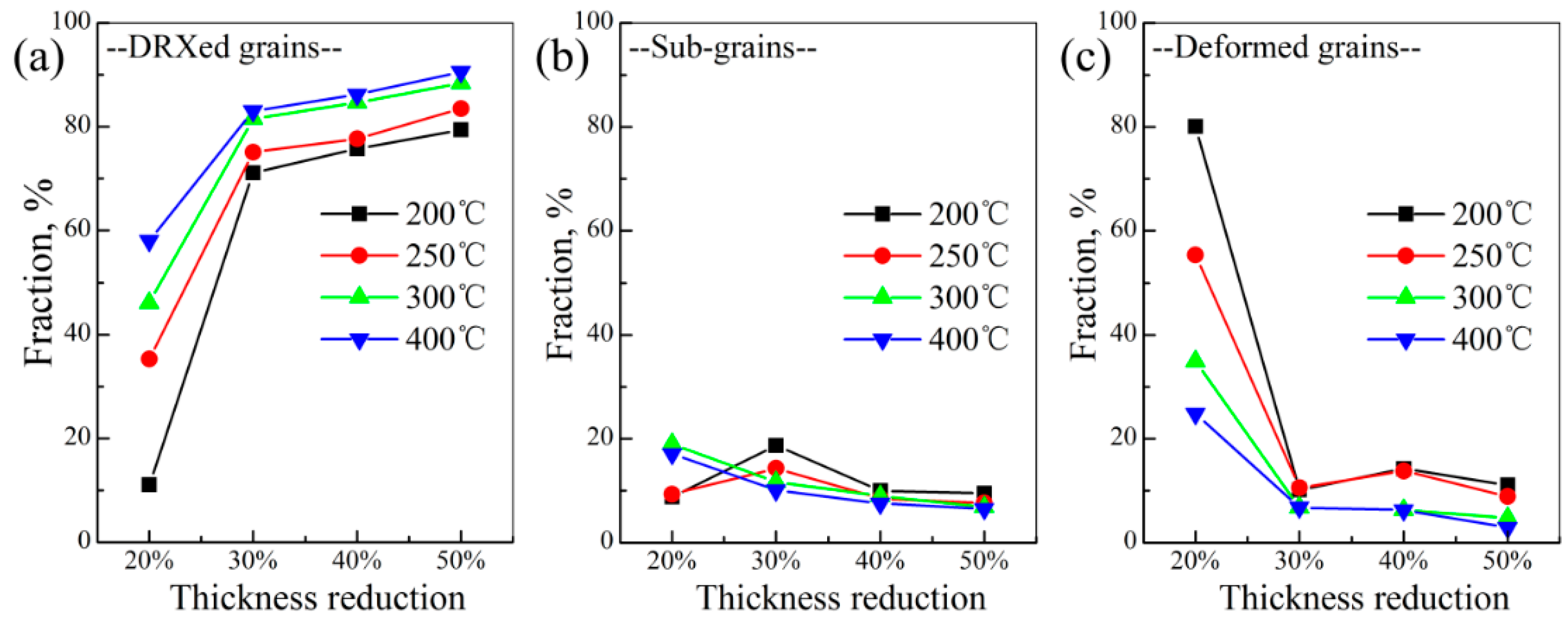
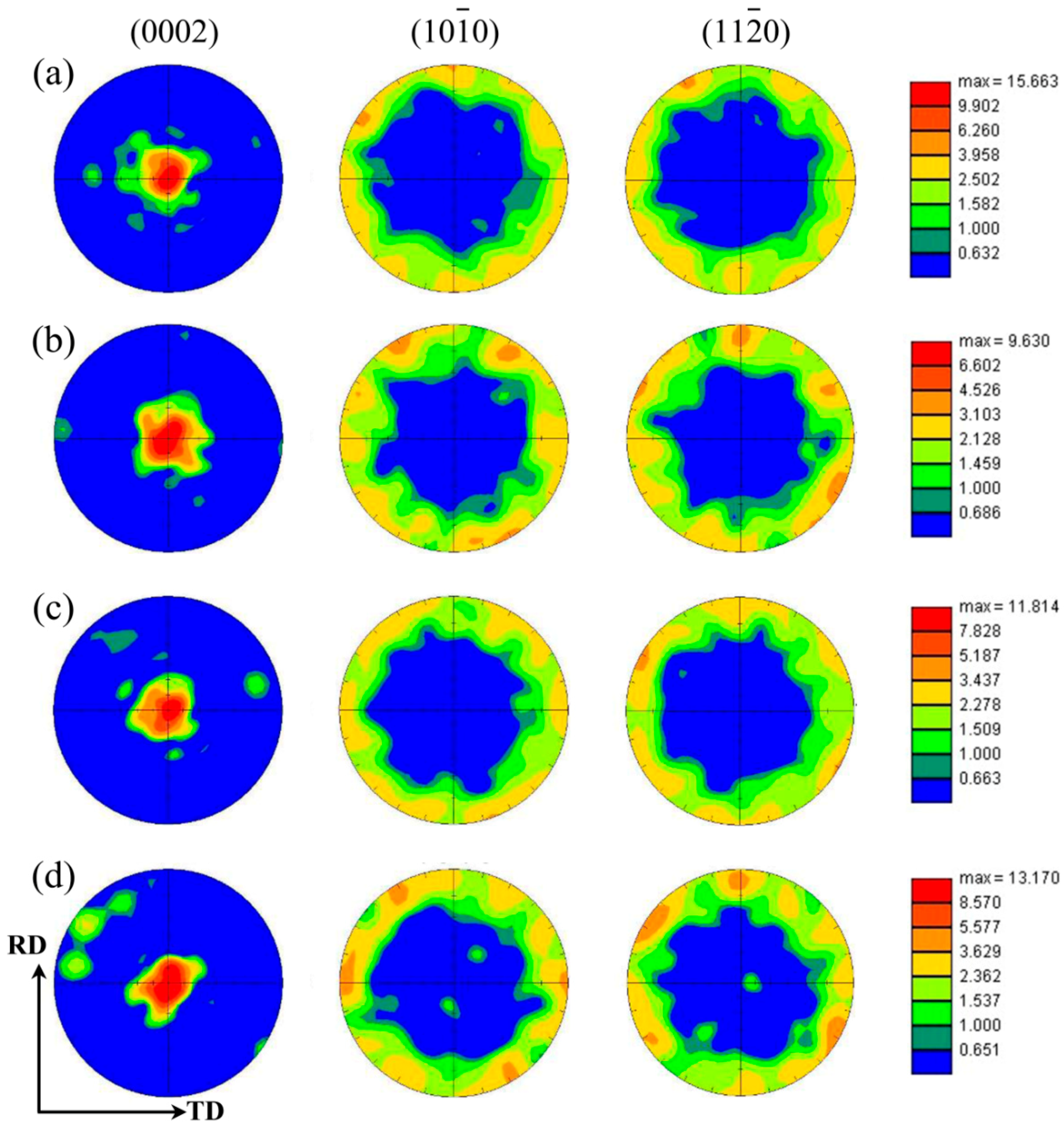
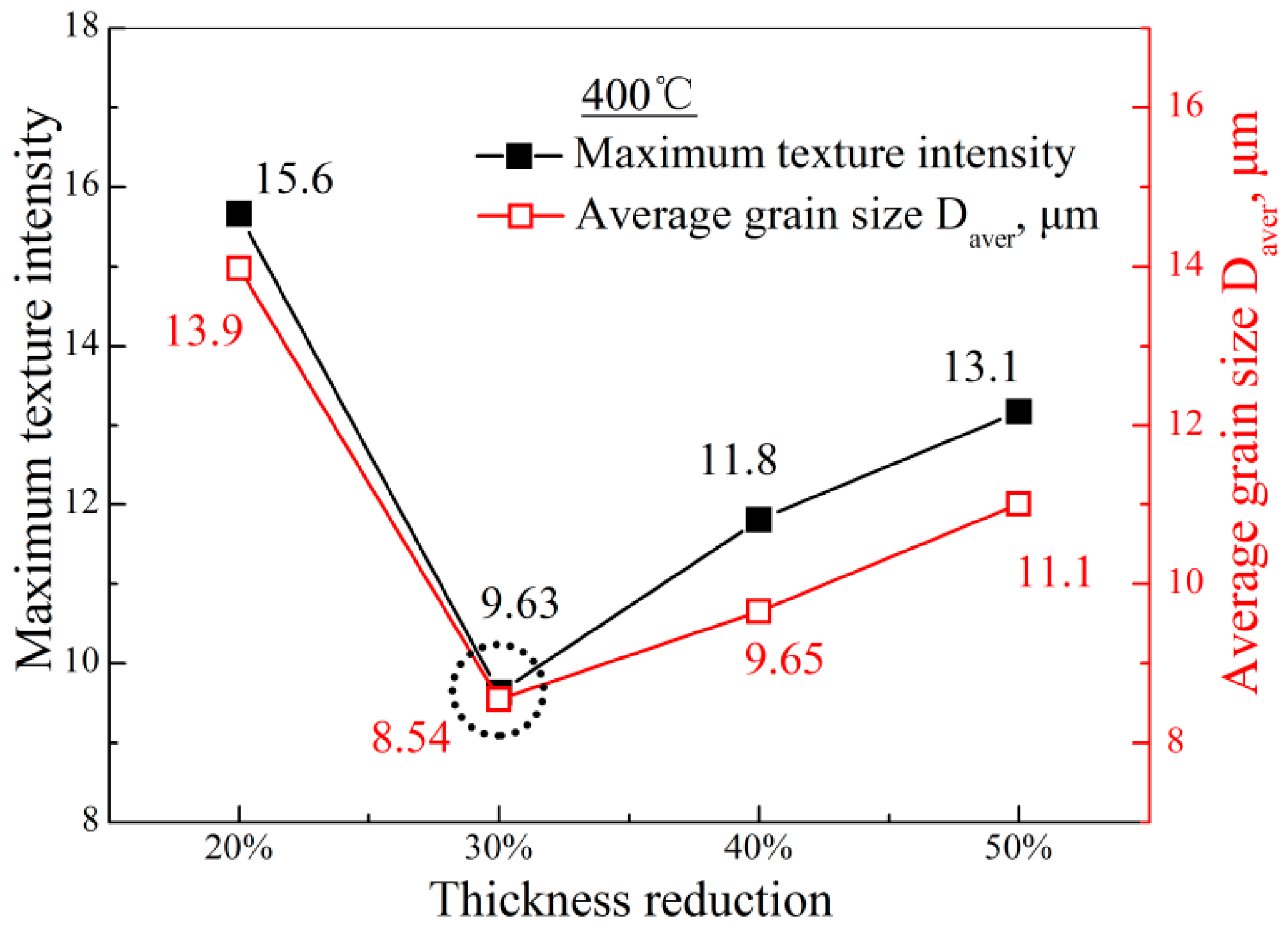
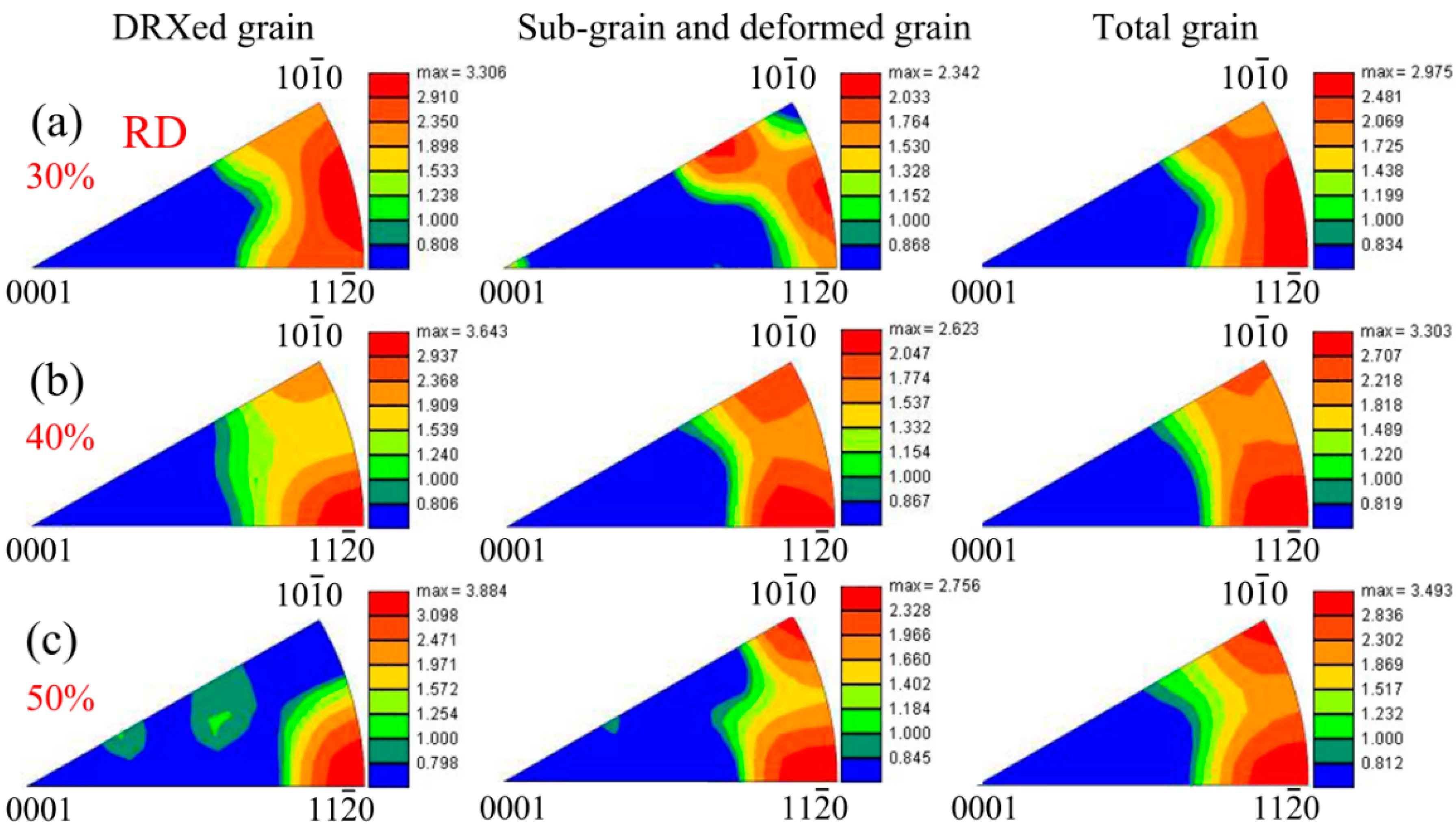
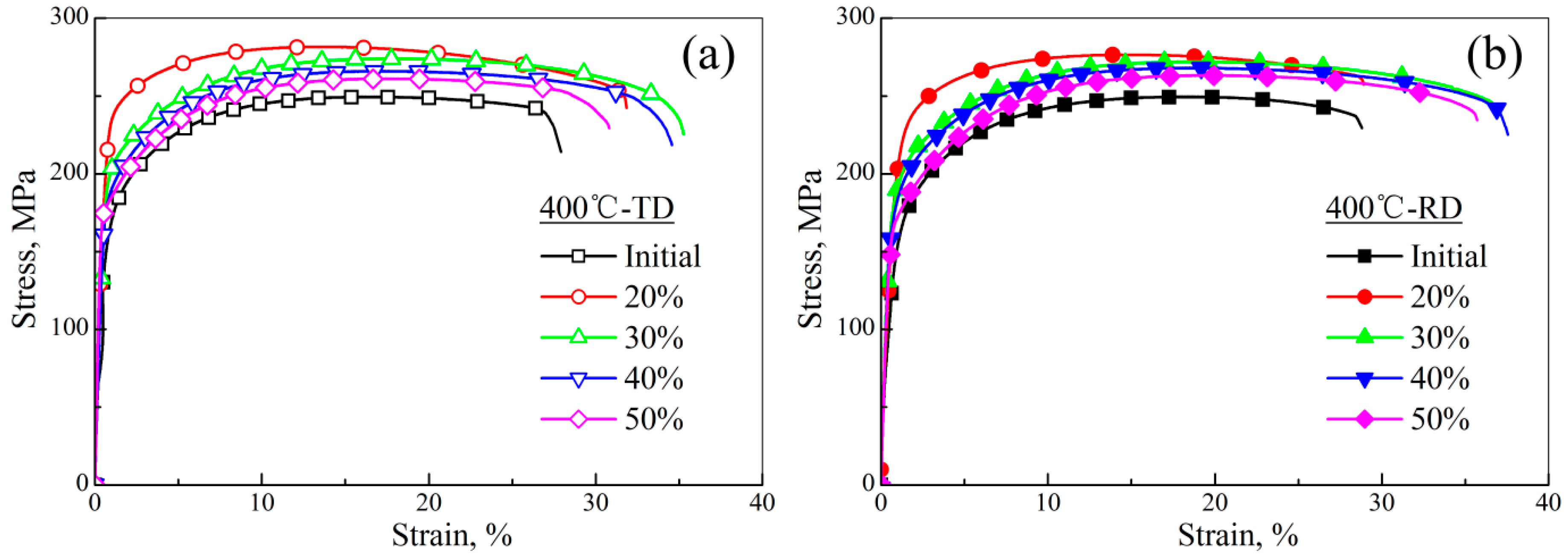

| Initial Thickness (mm) | Rolling Temperature (°C) | Thickness Reduction (%) | |||
|---|---|---|---|---|---|
| 4 | 400 | 20 | 30 | 40 | 50 |
| 4 | 300 | 20 | 30 | 40 | 50 |
| 4 | 250 | 20 | 30 | 40 | 50 |
| 4 | 200 | 20 | 30 | 40 | 50 |
| Condition | YS, MPa | UTS, MPa | FE, % | |||
|---|---|---|---|---|---|---|
| TD | RD | TD | RD | TD | RD | |
| Initial | 142.1 ± 3.1 | 123.8 ± 2.6 | 249.7 ± 3.3 | 248.5 ± 2.9 | 27.9 ± 0.5 | 28.8 ± 0.2 |
| 20% | 216.8 ± 2.8 | 192.3 ± 2.3 | 284.1 ± 2.6 | 276.3 ± 2.4 | 31.9 ± 0.3 | 28.9 ± 0.5 |
| 30% | 185.3 ± 2.3 | 167.3 ± 1.8 | 273.9 ± 2.4 | 271.8 ± 2.0 | 35.3 ± 0.6 | 36.7 ± 0.3 |
| 40% | 180.6 ± 3.2 | 165.4 ± 2.4 | 263.5 ± 3.3 | 266.5 ± 2.7 | 34.5 ± 0.4 | 37.6 ± 0.4 |
| 50% | 177.0 ± 1.9 | 157.9 ± 2.7 | 261.4 ± 2.2 | 260.7 ± 2.8 | 30.8 ± 0.5 | 35.7 ± 0.4 |
© 2018 by the authors. Licensee MDPI, Basel, Switzerland. This article is an open access article distributed under the terms and conditions of the Creative Commons Attribution (CC BY) license (http://creativecommons.org/licenses/by/4.0/).
Share and Cite
Wang, W.; Miao, Q.; Chen, X.; Yu, Y.; Zhang, W.; Chen, W.; Wang, E. Critical Rolling Process Parameters for Dynamic Recrystallization Behavior of AZ31 Magnesium Alloy Sheets. Materials 2018, 11, 2019. https://doi.org/10.3390/ma11102019
Wang W, Miao Q, Chen X, Yu Y, Zhang W, Chen W, Wang E. Critical Rolling Process Parameters for Dynamic Recrystallization Behavior of AZ31 Magnesium Alloy Sheets. Materials. 2018; 11(10):2019. https://doi.org/10.3390/ma11102019
Chicago/Turabian StyleWang, Wenke, Qing Miao, Xuemin Chen, Yang Yu, Wencong Zhang, Wenzhen Chen, and Erde Wang. 2018. "Critical Rolling Process Parameters for Dynamic Recrystallization Behavior of AZ31 Magnesium Alloy Sheets" Materials 11, no. 10: 2019. https://doi.org/10.3390/ma11102019




